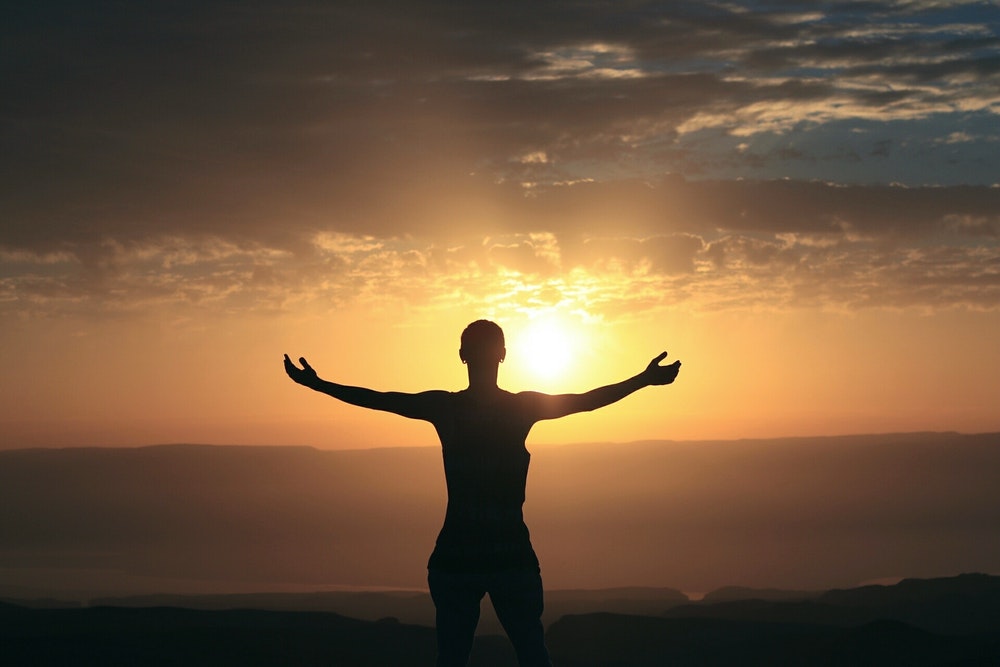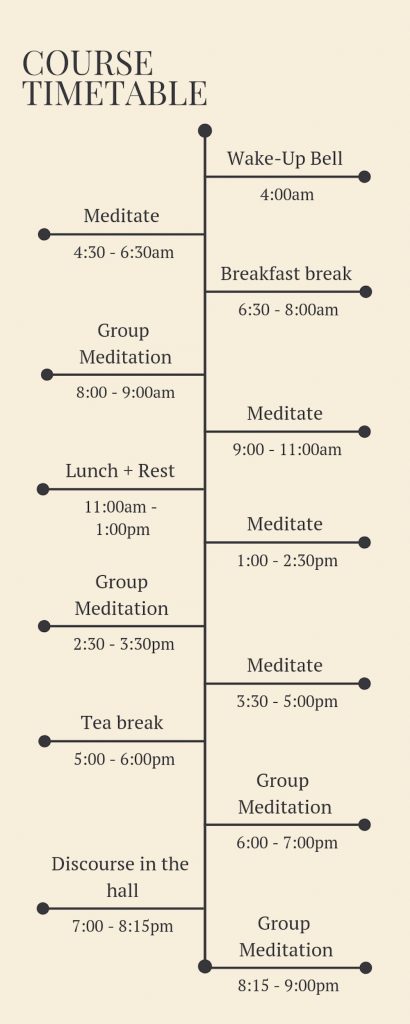“There is only one place to find real peace, real harmony. That place is within.”
– S.N. Goenka
This quote stems from the initiator and one of the leading promoters of the now up-and-coming meditation method of Vipassana, S.N. Goenka.
In the course of this article, you get to know the history as well as the overview of a classic Vipassana meditation retreat up close.
Besides, I would like to share some insights into my personal experience and provide some of the general Vipassana benefits for each and every one of you.
Let’s start clarifying what Vipassana meditation actually is about and where its origins lie.

What is Vipassana Meditation?
This form of meditation was supposedly brought up by Buddha himself who found enlightenment by the help of this very technique.
If that depicts the true root of this type of meditation may anyone’s guess, of course.
The core principle of Vipassana is to shape and strengthen equanimity.
The gained skill is to transfer into everyday life situations.
Next, to that, one further goal is to purify the mind from mental impurities such as anger, hatred, passion, and fear among others.
In general, the theory states that we can improve our life by adjusting the perspective we use to evaluate things.
It assumes that any pleasant and unpleasant sensation we perceive is the origins of misery.
Imagine, for example, all the nice things in the world you would like to buy or own. Most often, not attaining these kinds of physic objects makes us feel depressed.
Same applies to things that we profoundly hate and avoid.
That is why, instead of indulging in pleasant experiences or craving for physical objects, the meditation aims to train our ability to stay equanimous.
Same applies to any kind of aversive thoughts and unpleasant experiences we try to avoid and which frequently lead our behavior.
In place of constant avoidance patterns and miserable thoughts about things we really hate, equanimity helps to perceive comforts and aversions likewise neutral.
The most popular promoter of Vipassana was, and still is, S.N. Goenka.
He was a Burmese-Indian teacher who started to spread the word from 1969 on as a Vipassana teacher.
It was also him, who emphasized that the meditation is independent of any religion, therefore universal, and is of scientific character.
As of my personal Vipassana experience, I would absolutely confirm this.
Of course, in part of the meditation sessions chantings in Pali or Hindi occur.
These chantings, however, were only played at the very beginning or end of the session, signalizing either of both.
The core message of these chantings was “Bhavatu Sabba Mangalam”, which translates into “May all beings be happy”.
This statement, in my opinion, cannot be projected on Buddhism solely but on the interaction between all human beings on earth, unattached of any religion.
The meaning of the claim seems to subtract a lot of religious relation from Vipassana meditation.
Now, that we have figured out some of the background facts about Vipassana, we should take a closer look at the actual meditation.
In general, the meditation entails two parts:
- Anapana
- Vipassana
Let’s take a closer look at each of them in the following.
Anapana
Anapana resembles the first step in the direction of proper Vipassana meditation.
Without exception, the first three days of a 10-day Vipassana retreat are devoted to this introductory part of Vipassana.
During Anapana, the participants of the retreat only concentrate on their respiration in the triangular area below the nostrils and above the top lip.
Doing so, they try to notice any sensation that may become present in this very area.
Explicitly, the task is only to notice the sensation and not to respond to it in any positive or negative related manner.
This is in contrast to other types of meditation where the meditating person is asked to consciously control or adjust their breath in order to reach effects.
By practicing Anapana first, the participants achieve heightened sensibility for sensations throughout the whole body.
Also, their mind’s concentration is sharpened.
This fact will matter in the further course of the Vipassana retreat.
Vipassana
In the next part of their retreat, that is from the fourth day on, participants start to practice Vipassana itself.
Now, contrary to the aforementioned Anapana technique, participants no longer focus on the triangular area but start to scan their whole body.
Starting at the head, each and every part of the body is thoroughly observed.
Still, the mission is not to fall for pleasant or unpleasant sensations but to monitor those and remain equanimous.
In addition, starting to perform the Vipassana technique during the retreat includes three one-hour sessions in form of group meditation.
One of these sessions’ objectives is to keep the same posture for one hour, closed-eyed and equanimous.
In the following, I will elaborate on the group meetings more deeply.
Continuing to the next section of this entry, I will display more details about the retreat’s schedule too and incorporate some of my personal experiences.
How a Vipassana retreat looks like

First of all, basically taking part in a Vipassana retreat is free of charge.
The courses run solely on a donation basis.
In order to be eligible to donate, you must have completed one 10-day course at least.
This system makes sure that the method is not shared in a commercial purpose but rather because former students have benefitted before.
You can attend the courses in places all over the world. The original meditation center
The standard amount of time for a Vipassana retreat is at least 10 days.
There is no course that has a shorter period to offer.
Only this period is appropriate in order to conduct both, Anapana and Vipassana, appropriately.
However, there are advanced courses for meditators that have participated in a retreat a certain number of times before.
These courses last up to 60 days for the most professional Vipassana teachers and assistants.
Precepts
There are several conditions that students must adhere to in order to draw the most potential benefit out of their stay.
The precepts serve somewhat of a perfect working atmosphere that enables the participants to fully engage in the meditation without any distraction from their environment.
For the preparation of the course, prospective participants are asked to abstain from all intoxicants at least four weeks prior to the start of the retreat.
In regard to the actual stay, there are several more precepts that the students need to follow.
These are:
- Abstain from killing any being
- Abstain from stealing
- Abstain from all sexual activity
- Abstain from telling lies
Above that, old students, that is those who already completed at least one retreat, must not eat anything after midday.
For the whole duration of the course, Noble Silence has prevailed, meaning, that no kind of communication is allowed, neither verbally nor non-verbally.
Next to that, there is a strict separation of sex. Women and men are able to see each other on the grounds however, they sleep, eat, and meditate detached.
Any kind other kinds of potential distractions such as books, audio devices, mobile phones, and writing materials are prohibited as well.
Participants shall cultivate a feeling of working in isolation, dissociated from as much as possible of the “outside world”.
In my first retreat, I experienced this framework to be a very helpful guideline.
By adhering to these requirements, you can focus completely on the meditation itself.
Furthermore, you also need to deal with the fact that you are all alone with your thoughts. You are not able to communicate them but focus on practice to be unaffected.
Of course, if there is an urgent need for a talk, there are the assistant teachers that you can consult anytime.
Also, there is a definite time slot for talks with the teacher around midday.
This slot, however, is supposed to be used only if necessary but not to simply relieve yourself from your frequent thoughts.
Schedule
Participants arrive at the meditation center until 2:00 pm on the first day.
The course itself begins with a registration and orientation phase.
Most of the personal belongings are consigned to the so-called servers.
Students are divided up into dorms of different sizes.
The first meditation is being held in the evening of arrival. From that point on, Noble Silence holds.
For the next 9 days, each day is structured in the same way, as you can see in the timetable.
The day starts with the morning bell at 4:00 am and lasts until 9:30 pm.
In between, there is a total of almost eleven hours of meditations.
Don’t worry about the huge amount of meditation right away.
If you do not feel like you can concentrate anymore or anything alike, certainly you can take a nap in your room instead of meditating.
Most important are the group meditations in the common hall.
As noted earlier, from the fourth day on this is the crucial session in which equanimity is trained seriously.
Just try to imagine the feeling once certain parts of your body seem to tear apart after only 20 minutes of meditating. The only thing you desperately think about is “Move!”.
That’s the time when the actual task starts and one needs to get through this, without falling for your pain but remaining resistant.
During the period of the course, it becomes easier, as I can happily assure.
Apart from the group meditations, there are multiple slots determined for meditation either in the common hall or in your room.
As well, there are breaks for breakfast, lunch, and tea respectively.
My personal highlight of the day was the “teacher’s discourse” in the evening in the common hall.
At that time, all the students watched a video recording which shows S.N. Goenka talking about the course and providing further insights.
These insights concern backgrounds of the technique and analogical narratives which made me and all the others (I suppose) understand why we were suffering throughout the daily group meditations.
Also, since we could not speak with each other, his stories made us aware that everyone is challenged by the retreat in the same way.
As I progressed throughout the course, meditation and thought handling went better and better.
On the tenth day of the course, Noble Silence is ruptured.
Also, the separation of women and men dissolves and the students can talk with each other, exchange their experiences, and just get to know the others after living with them in some kind of community for 10 days.
I experienced that day as a day of holistic happiness.
Everyone was happy he or she made it up to that final point and were even more happy about the knowledge gained in the past days.
Not only knowledge about meditation and the technique, but most of all knowledge about oneself.
The retreat comes to an end on the morning of the eleventh day.
There is one final group meditation and the community of participants cleans the whole area so that subsequent courses can start seamlessly.
Benefits of Vipassana for Everyday Life
For sure, I think there are countless aspects in which you can benefit from participating in a Vipassana course also in your Everyday Life.
In the following, let’s name only a few of those.
- Focus
Students spend their time during such a retreat in complete isolation of the outside world. There is plenty of time for self-reflection. No distractions such as e-mails, phone calls or WhatsApp messages. Once you got to know that feeling and everything that comes about, you can easily transfer that sense into your everyday life.
It takes effort though, of course. - Mobility
Remaining in the very same position for one hour three times a day definitely strengthens your mobility. After having succeeded in this domain first, it becomes much easier to translate that determination to other everyday mobility demanding tasks. - Failure resistance
Given the intensity of each group session, you might fail to accomplish not to move in the beginning. You might even fail to complete the first retreat you are participating in. However, you get to know that this is a continuous process which progressively takes you to the desired state. Therefore, you become resistant to failures and learn to cope with them.“Our goals can only be reached through a vehicle of plan, in which we must fervently believe and upon which we must vigorously act. There is no other route to success.” – Pablo Picasso
- Impermanence
Throughout the course, you become more and more aware of the impermanence of things. Likewise, in everyday life, neither bad times nor good times stay for long. You start to interrogate your habits and vices. Instead of indulging in potential future states and dwell about the past, you learn to appreciate the beauty of the present time.
This, in my opinion, is one of the major aspects that makes life enjoyable the most. - Equanimity
Acquiring equanimity basically portrays the main focus of Vipassana, as noted earlier. Students detach from appraisals about either pleasant sensations or unpleasant ones. As with impermanence, you become mindful about the fact that life consists of frequent changes between either of both. In your daily life then, you no longer hunt for joyful experiences and complain about how bad your life is going all the time.
Instead, you are thoughtful and become more and more balanced, unaffected by any external circumstances in your direct environment.
Conclusion
During this article, I hope I could provide you essential insight into the practice of the Vipassana method.
In general, it is known to be a very intense form of meditation.
Most of the reviews I have read so far, do not recommend this type for beginners.
When I did the retreat the first time, however, I began as a complete novice in regard to meditation.
Of course, it was a tough period of 10 days for me as well, but I think it is absolutely manageable.
In advance to the stay, there are several health-related conditions that are being checked by the organization team (in form of a questionnaire).
That is, in case you have already had serious psychological problems beforehand, attending a Vipassana retreat may not be the ideal option for you.
Apart from that, I can deeply recommend participating in one of the Vipassana retreats that are being offered worldwide.
For further information, check out this introduction video from the man himself, S.N. Goenka:
What are your experiences with meditations in general? Have you any other technique that you prefer over Vipassana?
Let me know in the comments!
Cheers,
Janik




